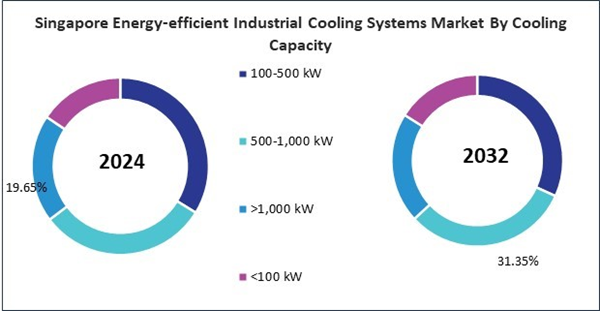The China market dominated the Asia Pacific Energy-efficient Industrial Cooling Systems Market by country in 2024, and is expected to continue to be a dominant market till 2032; thereby, achieving a market value of $1.47 billion by 2032. The Japan market is showcasing a CAGR of 9.4% during 2025-2032. Additionally, the India market would register a CAGR of 11% during 2025-2032.
With climate change taking center stage globally, particularly after the Kyoto Protocol and the Paris Agreement, industrial cooling technologies came under scrutiny. Governments began introducing stringent energy-efficiency standards, while international regulations like the Kigali Amendment encouraged a shift away from refrigerants with high global warming potential. In response, the market saw a transition towards more environmentally friendly and energy-efficient technologies. Innovations such as variable frequency drives, low-GWP refrigerants, and thermal energy storage systems gained momentum.
Moreover, public-private partnerships have also shaped the landscape of this market. For example, Singapore introduced a novel district cooling system in 2021, enhancing the efficiency of centralized cooling networks by tripling their energy transfer capacity. Similarly, Enwave's deep lake water cooling system in Toronto - a pioneering infrastructure project expanded in 2019 with federal backing - showcases the potential of natural resource-based cooling.
The Asia Pacific (APAC) region, comprising economic giants like China, India, Japan, South Korea, Australia, and the rapidly industrializing ASEAN nations, is experiencing massive growth in demand for industrial cooling systems. This surge is fueled by urbanization, digitization, manufacturing expansion, and increasing data infrastructure development. However, rising temperatures, high humidity, and tightening energy regulations have placed energy efficiency at the heart of industrial cooling decisions.
List of Key Companies Profiled
- Johnson Controls International PLC
- ABB Ltd.
- Schneider Electric SE
- Trane Technologies PLC (Thermo King)
- Vertiv Group Corp.
- Daikin Industries Ltd.
- Emerson Electric Co.
- LG Electronics, Inc. (LG Corporation)
- Honeywell International, Inc.
- Fujitsu Limited
Market Report Segmentation
By Deployment
- New Installations
- Retrofit Installations
By Cooling Capacity
- 100-500 kW
- 500-1,000 kW
- >1,000 kW
- < 100 kW
By Industry
- Data Centers
- Food & Beverage
- Electronics Manufacturing
- Pharmaceuticals
- Automotive
- Food Retail
- Other Industry
By Country
- China
- Japan
- India
- South Korea
- Singapore
- Malaysia
- Rest of Asia Pacific
Table of Contents
Companies Mentioned
- Johnson Controls International PLC
- ABB Ltd.
- Schneider Electric SE
- Trane Technologies PLC (Thermo King)
- Vertiv Group Corp.
- Daikin Industries Ltd.
- Emerson Electric Co.
- LG Electronics, Inc. (LG Corporation)
- Honeywell International, Inc.
- Fujitsu Limited









